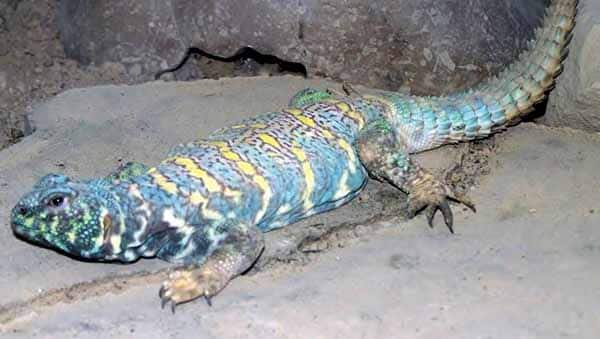There are approximately 19 to 22 species of Uromastyx belonging to the Old World lizard family Agamidae
There are approximately 19 to 22 species of Uromastyx belonging to the Old World lizard family Agamidae (“approximately” because some were reclassified recently to the genus Saara), and the ornate uromastyx (U. ornata) is one of my personal favorites. This colorful species originates from desert regions of Egypt, Israel and Saudi and northern Arabia, where it inhabits dried water routes between cliffs, called “wadi,” the alluvium bed between the mountains, in cracks and among rocks. It digs burrows for egg laying and to escape the desert heat.
More Information About Uromastyx Lizards
Large Scale Uromastyx Hunting Condemned in Saudi Arabia
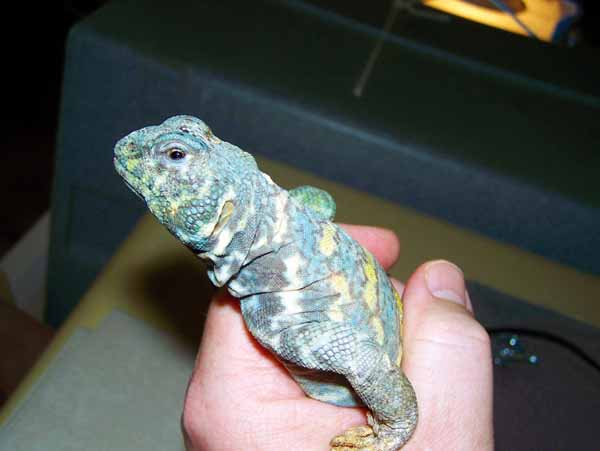
troy jones
All ornate uromastyx exhibit yellow ocelli on their backs, though they are brighter on the males.
Although there has been talk of up-listing U. ornata to Appendix I of the Convention on International Trade of Endangered Species (CITES), it is currently listed in Appendix II, which allows wild-caught specimens to still be exported from some locations. Back in the early to mid-1990s, ornate uromastyx were imported into the U.S. in great numbers, but the wild-caught lizards did not adjust well to captivity. Much of their care in those days was experimental because we did know much about their wild environment, foods or how best to care for them. Then, in 2000, Danny Molco and Ben David Osnat published a four-year field research study that concluded that U. ornata is an herbivore. An analysis of droppings showed they were comprised of only 1 percent insects, most likely ants consumed by accident that were on flowers the lizards had eaten. This discovery caused Uromastyx keepers to stop feeding insects, resulting in much healthier captives.
There has been much advancement in the care of the captive ornate uromastyx since 2000—another important finding from the same study showed that wild ornate uromastyx are solitary animals that come together only to mate—and with this article I will share what I’ve learned from keeping and breeding U. ornata off and on since the late 1990s.
A Beautiful Desert Dweller
Ornate uromastyx are medium-sized lizards that typically attain adult lengths of about 14 inches. Males are usually leaner than females, and like other Uromastyx species, ornates are equipped with a very spiny tail that is used for defense, as well as to block burrow entrances or crevices in which the lizards take refuge.
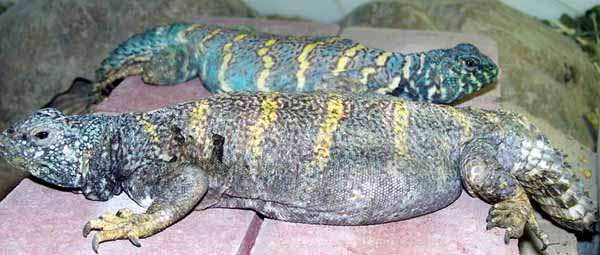
troy jones
This is a pair of the author’s adult ornate uromastyx. The female is in front.
Ornate uromastyx are sexually dichromatic. Male base colors on the back are green, blue and sometimes red. Females are more neutral tans to pinks. Both sexes exhibit yellow ocelli on their backs, though these are usually much brighter on the males. Not all males are exceptionally colorful, but the ones that are can be very impressive. It takes them three to six years to achieve their full color, and during the breeding season adult males become especially colorful. Occasionally a female ornate will be super colorful—the rare ones that are, are known as “male mimics,” and these can be extremely beautiful.
The ornate is considered the couch potato of the Uromastyx. Adults tend to be fairly sedentary and spend much of the day basking and eating. Juveniles, however, are extremely active and masterful climbers.
Ornate Uromastyx Enclosure
Never keep different species of Uromastyx in the same enclosure (e.g., don’t keep ornates with Saharans, don’t keep Saharans with Malis, etc.). Different species come from different deserts with different climates, humidity, food and diseases. Also, you don’t want to cross-breed separate species, so please keep one species per cage.
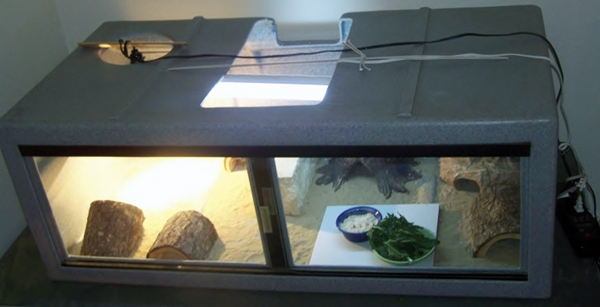
troy jones
The author houses his uromastyx singly in 2 by 4-foot enclosures, such as this one from Neodesha.
Ornate uromastyx can be housed in groups, but this doesn’t always work out. Sometimes a male and a female or two can get along, but more often than not they will need to be separated. I have a few pairs that I house together for six months out the year, but otherwise I house about 90 percent of my lizards singly.
When I began keeping ornates in the late 1990s, I kept them in 40-gallon aquariums. I learned since then that aquariums are not great for these lizards. Ornate uromastyx need at least a 4 by 2-foot enclosure to allow the lizards to thermoregulate between hot and cooler temperature zones as desired. I also use 4 by 2-foot cages for newly hatched babies—again, in order to provide the proper temperature zones (see more about this in the lighting and temperature section).
I also learned that wild-caught ornates acclimate better in cages with three solid walls and glass only in front. I recommend wood, PVC, polypropylene or plastic cages. I purchased the majority of mine off craigslist, and almost all of them had burns in the plastic. I buy damaged enclosures at a discounted price, and my father-in-law cuts out the melted areas, allowing me to reuse cages that otherwise would’ve been thrown out. In the case of models such as Vision 422 cages, he also cuts off the low-hanging tube. This allows me to use higher-wattage light bulbs and creates a better airflow system, which is particularly helpful to me because I have more than 20 enclosures in the same room.
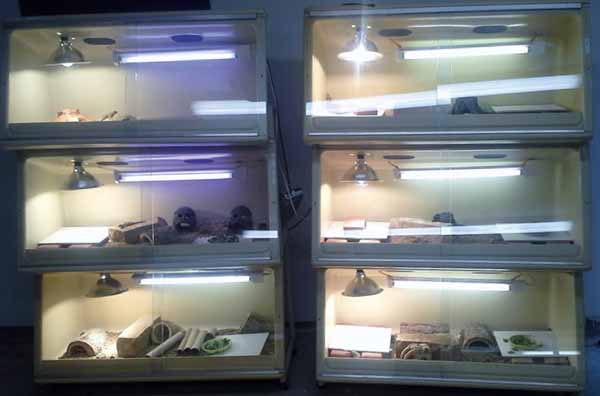
troy jones
For basking lights, I use GE and Sylvania standard and halogen clear light bulbs mounted in clamp lights, and I use 10.0 UVB fluorescent lights for my UVB lighting.
Rocks, tiles, caves, branches, etc. can all be used as cage furniture. If you use branches from outdoors, soak them in a light bleach solution prior to using. Make sure you offer at least three hides per cage, per lizard (though I double that in my cages). You can purchase clay and/or wooden hides, or get inventive and use tubes and pipes from your local hardware store. Paper towel and toilet paper rolls make great hides for babies and juveniles.
Uromastyx Lighting and Temperature
Because I have more than 20 enclosures all in the same room, what works for me may or may not work for the average person with a smaller number of cages. For basking lights, I use GE and Sylvania standard and halogen clear light bulbs mounted in clamp lights, and I use 10.0 UVB fluorescent lights for my UVB lighting. To remain effective, UVB fluorescent lights need to be replaced every six to 12 months.
Uromastyx absorb heat from above, not below. Do not use under-tank heaters with them, as they may not be inclined to move off these prior to being burned (it can take lizards a while to feel uncomfortable enough to move, and by then they can already be injured).
As mentioned, ornate uromastyx need to be able to thermoregulate, and they need proper temperatures to digest their food, as well. Concentrate basking lights at one end of the enclosure and maintain the basking area at 120 to 130 degrees Fahrenheit. The opposite, cooler end of the cage should be kept at 80 to 90 degrees.
You can increase or decrease the basking temperature by raising or lowering your basking light, or if the basking area needs to be hotter, build a platform under the basking light (but be careful that the lizard can’t touch the light, to avoid a burn).
While my preference is to use separate heat lights and fluorescent UVB lights, many breeders prefer to use the all-in-one, UVB/heat mercury vapor lamps instead. The choice is yours.
Potential Substrates
I have used millet, bird seed, sand, rock, tile, bare floor, etc. as substrate with my uromastyx. All have drawbacks, however, and I have yet to find a substrate that I consider perfect.
I do not recommend calcium sand or crushed walnut shells for uromastyx bedding, as these may cause intestinal impaction that could be fatal to your lizard. A bare cage bottom eliminates the worry of the lizard ingesting any substrate, but it’s also very messy when the lizard has a bowel movement and then walks through and smears feces all over the floor of the cage, as well as on its own belly. It can also be quite a chore to clean rock, tile and bare-floor enclosures, especially if you’re raising a couple dozen uromastyx all in separate enclosures.
Play sand can be used, but be sure to wear a face mask when you’re stirring or sifting it. Millet is great for both male and female ornate uromastyx that you’re not planning to breed. If a female lays eggs on millet, however, it can be a nightmare because it’s almost impossible to dust the millet off the eggs. If eggs are placed in an incubator and left for a few days, the millet will sprout and damage the eggs.
Newspaper is a good bedding option. It’s not very pretty, but it is practical and allows for easy clean-up.
Acclimation and Handling
Quarantine new uromastyx in separate enclosures for the first three to six months. I have found that those that are housed singly exhibit the best health and growth rates.
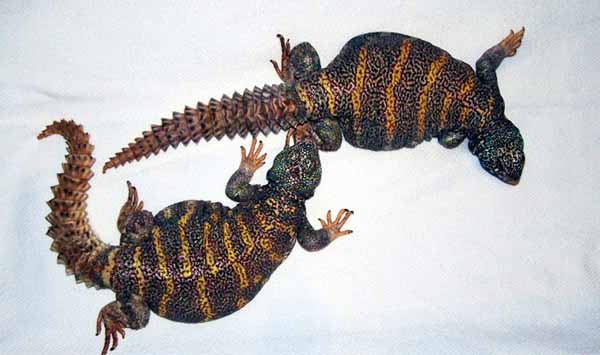
troy jones
These two uromastyx are sisters.
Acclimation is the most important step in establishing a new uromastyx. Captive-bred lizards generally acclimate the quickest; wild-caught individuals can take up to six months. Don’t handle any uromastyx during its acclimation period except to weigh it. Weighing them every 30 days is one way I keep track of my lizards’ health. Significant weight loss could mean a health issue; seek professional advice from a qualified veterinarian if your ornate is losing a lot of weight.
During acclimation, cover any glass walls, front, etc. in the lizard’s enclosure. I feed and clean before the lights come on in the morning, but otherwise leave newly acquired lizards alone for the first couple months to let them settle in.†
If you want to handle a new ornate uromastyx, wait a month or two to allow it to settle in. Then slowly begin by getting it to eat out of your hand. Once it’s doing that, then try handling for short periods, slowly extending them over time. All lizards have their own personalities and some will stand handling better than others.
Because they do best in heat, don’t keep a uromastyx out of its cage for more than an hour at a time. Mine are primarily display animals that I don’t handle too much. I enjoy setting up their enclosures and watching them bask and move about their cages. I also enjoy setting up breeding groups and producing captive-bred uromastyx.
Feeding Ornate Uromastyx
One advantage to keeping ornate uromastyx is that you don’t have to mess with feeder insects, as they don’t require them to be healthy.
I am always looking for new types of edible flowers, vegetables and greens to add to my garden, to expand the number of food items I can offer my uromastyx. I start with a good mix of greens and edible flowers. You can dust this salad with Miner-All D3 calcium supplement once or twice per month, if necessary, but with proper diet and UVB, the lizards won’t really need this supplementation.
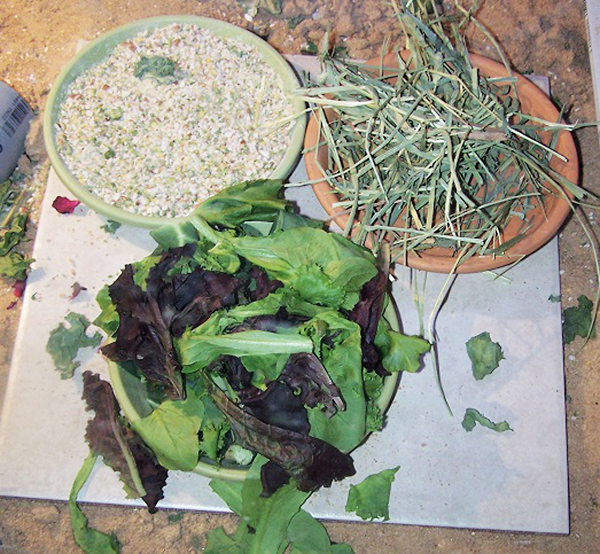
troy jones
A sample of foods the author offers his uromastyx, including bird seed, hay and greens.
Keep a small bowl of uncooked, ground-up green peas, lentils, various beans and bird seed in all sub-adult and adult uromastyx enclosures (do not offer this to uromastyx less than 6 months old). Occasionally, add pure bee pollen granules to this mix.
Being desert creatures, ornate uromastyx get all their water needs from greens and vegetables, and it is not necessary to keep a water dish in their cages. I offer fresh greens, flowers and vegetables on a 12-inch-square tile to try and keep food items out of the sand substrate. Sometimes the uromastyx will let the food items dry out and eat them dry, which is fine. Most greens, flowers, vegetables and grasses that are safe for tortoises are safe for ornate uromastyx. Below is a list of the different types I offer my lizards.
Greens. I feed a mixture of spring mix, mesclun, micro greens, arugula, collard greens, turnip greens, mustard greens, escarole, endive, bok choy, dandelion greens and some (not too much) kale.
Herbs. This year I am growing basil, parsley, sage and garlic chives.
Edible flowers. I offer my uromastyx edible flowers whenever they’re available. If you plan to do likewise, grow them organically and use no pesticides. Types that can be offered include dahlia, day lily, dandelion, chrysanthemum, hibiscus, hollyhock, mustard flower, marigold, nasturtium, rose petals, geraniums, pansies, violets and pumpkin flower. Pull the flowers apart and rinse well prior to feeding.
Grass. I have recently begun offering timothy hay to my ornates, and they seem to love it. I’m also growing Bermuda grass for them.
Sexing and Breeding Ornate Uromastyx
As mentioned earlier, ornate uromastyx males are usually much more colorful than the females. In addition, you can sex them by head shape and size—males’ heads are somewhat broader than females—and whether hemipenal bulges are present. To check for these, hold the lizard upright in your hand and gently bend its tail toward the ceiling. Look just below the lizard’s vent; if you see a V-shaped row of scales, it’s a male; if this is not present, you’ve got a female. Ornate females take on a pear shape as adults, too, and they have a flap of skin on their neck that a male will grab onto during copulation.
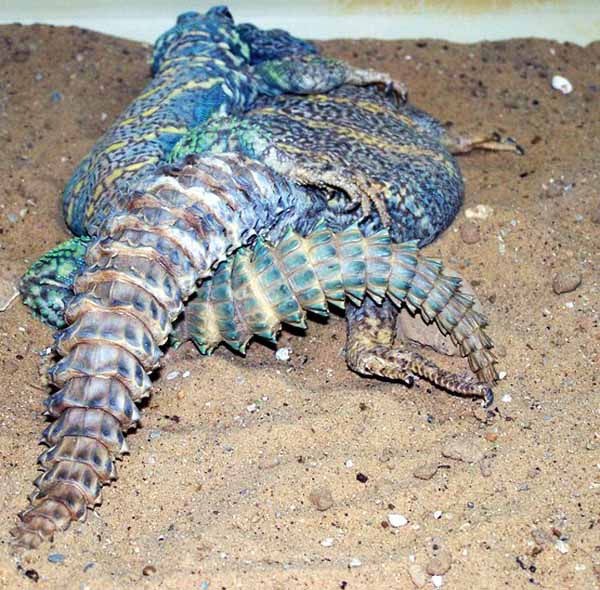
troy jones
Ornate uromastyx breeding can involve a fair amount of biting and dragging around prior to actual copulation.
I put my uromastyx through a light brumation this year to encourage breeding, based on this schedule:
- December 1, 2014: Cut lights to six hours per day
- December 15: Cut lights to four hours per day
- January 31, 2015: Restored lights to six hours per day
- February 15: Restored lights to eight hours per day
- February 28: Restored lights to 12 hours per day
After this, I place males and females together, and hopefully breeding activity will result. Uromastyx mating can be violent and is not for the faint of heart. It may begin with various circling behavior and push-ups by the male, perhaps with the female flipping over to indicate she’s not ready to breed. Eventually, a determined male will bite onto the fold of skin around the female’s neck and hang on to it. He may even pull the female around the enclosure by this fold of skin.
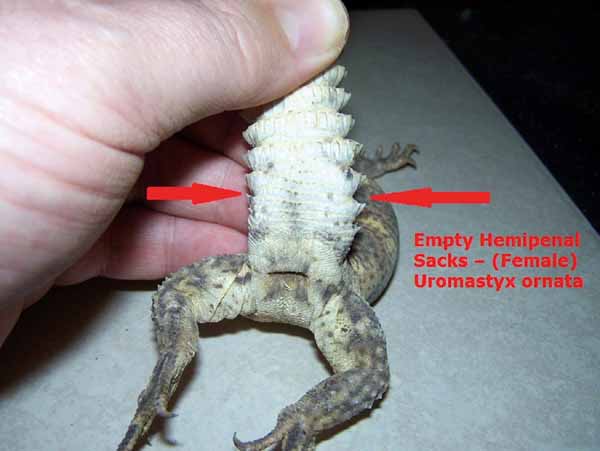
troy jones
Eventually, he will position himself on the female’s back and wiggle his tail next to hers until she raises it. The male will then wrap his tail beneath the female’s, all the while still biting and holding on to the skin on her neck, in order to position his vent over hers. He will then insert one of his hemipenes, holding the female in the mating position for two to 10 minutes.
If the breeding is successful and the female becomes gravid, she will lay her eggs after four to six weeks. Clutch sizes can be anywhere from four to more than 20 eggs, depending on the size, age and health of the female.
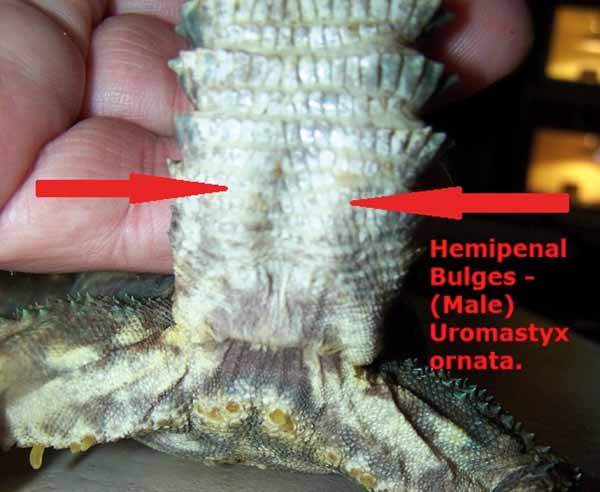
troy jones
One way to sex adult ornate uromastyx is to check the underside of the tail for hemipenal bulges found on the male.
Eggs and Incubation
I add an egg-laying box containing a mix of play sand and organic dirt to the cooler side of the female’s enclosure sometime between January and the first of February. Adding it at this time gives her a chance to get used to the foreign object before she actually needs it. If she doesn’t visit it at the cool end of the cage, I move it to the warmer end.
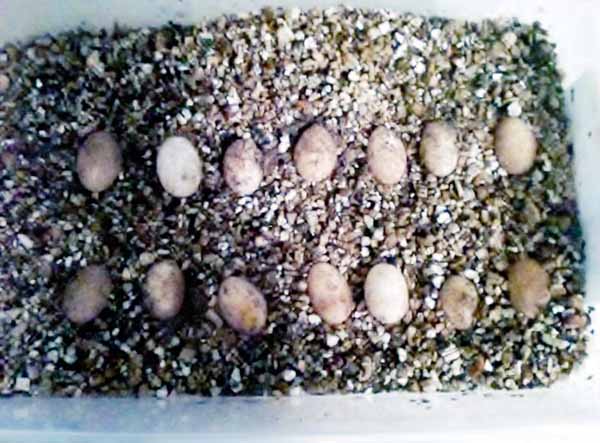
troy jones
A clutch of ornate uromastyx eggs typically numbers anywhere between four and 20 eggs.
You’ll know once the female has laid her eggs because she’ll be noticeably thinner immediately afterward. I offer unflavored Pedialyte to females after they have laid their eggs to rehydrate them. Egg laying takes a toll on the females, but usually within a week or two they gain back most of their weight and begin to resume normal feeding and basking.
I wear rubber gloves when carefully removing the eggs from the egg-laying box, and gently place them in plastic incubation containers in the same position that they were laid (there has been speculation about whether or not turning the eggs can harm them, so I play it safe).
I space the eggs an inch or so apart in moistened Perlite inside the incubation containers. Squeeze any excess moisture out of the Perlite, which should be just damp enough to clump in your hands. Once all the eggs are in place, I seal the lids and place the containers in the incubator.
I incubate ornate uromastyx eggs at 92 degrees for the first 50 days and then raise the temperature to 93 degrees for the duration. Weigh the plastic containers once a week to track evaporation levels. A day or two after the eggs are placed inside, moisture should build up on the sides of the plastic containers. If this doesn’t occur, you’ll need to add more water. I also keep an open container of distilled water in the bottom of the incubator to assist in humidity.
Following this incubation method, eggs should hatch out after 60 to 70 days.
Raising Uromastyx Hatchlings
My hatchlings are housed in their own individual 4 by 2-foot enclosures with similar basking and gradient availability and temperatures as is provided to the adults. Sometimes I’ll also use 55-gallon tubs, which measure approximately 42 inches long by 20 inches wide and are just shy of 17 inches tall. I keep hatchlings on paper towels, tile and/or bare floor. Do not try other substrates until the hatchlings are at least a year old.
Uromastyx hatchlings start feeding after the first day or two. I offer them the same greens as the adults, only I remove any stems and finely chop the greens. Remember, don’t offer hatchlings the dried beans or peas that the adults eat.
I do not offer my ornate babies water, though some other Uromastyx species seem to benefit from it. If I notice one looking dehydrated, I will try lowering the basking temperature a little and/or offer some water in a shallow container.
I learned how to keep and breed Uromastyx from Randall L. Gray back in the late 1990s and they’ve been my favorite ever since. The ornate uromastyx can be very hardy and makes a great pet if provided with the proper care described in this article. If you or your kids are looking for a rewarding vegetarian lizard to work with or to keep as a pet, Uromastyx ornata could fit the bill!
Troy Jones has been keeping and breeding reptiles periodically for more than 30 years. He is one of the founders of The Uromastyx Home Page (kingsnake.com/uromastyx), as well as the owner of the UroRanch website (UroRanch.com).

